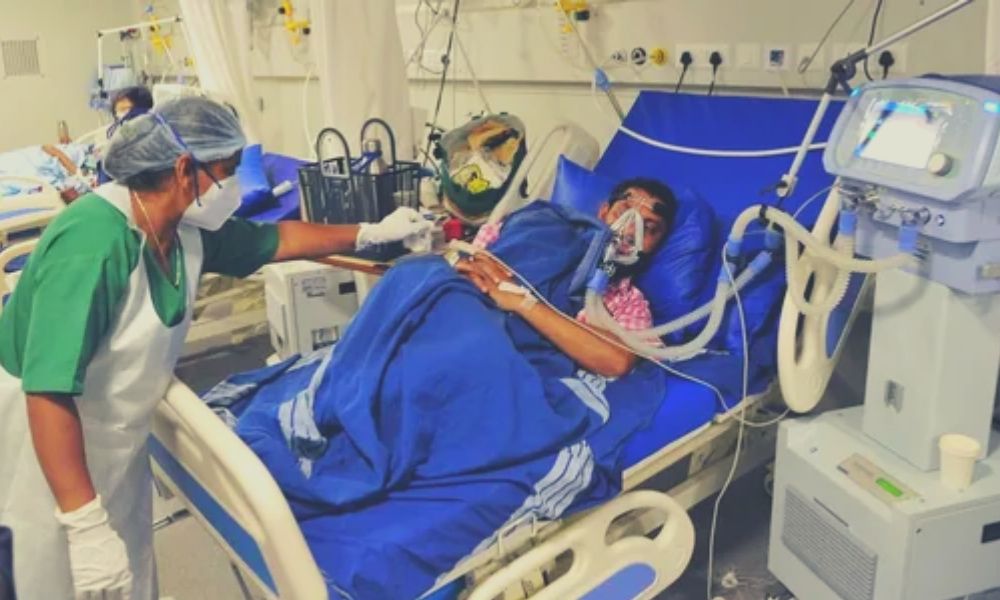
Image Credits: Hindustan Times
'Black Fungus' Cases On The Rise In India: All You Need To Know
Writer: Kathakali Dutta
Kathakali Dutta is a second semester student of the Master of Communication and Journalism (Integrated) programme at the School of Mass Communication, KIIT Deemed University, Bhubaneswar.
India, 22 May 2021 6:06 AM GMT | Updated 22 May 2021 6:18 AM GMT
Editor : Palak Agrawal |
Palak a journalism graduate believes in simplifying the complicated and writing about the extraordinary lives of ordinary people. She calls herself a " hodophile" or in layman words- a person who loves to travel.
Creatives : Palak Agrawal
Palak a journalism graduate believes in simplifying the complicated and writing about the extraordinary lives of ordinary people. She calls herself a " hodophile" or in layman words- a person who loves to travel.
Mucormycosis, also known as "black fungus", is a rare fungal infection caused by exposure to a group of molds called the mucormycetes commonly found in the environment. The infection can also result in permanent blindness and damages to the nose and jawbones and has an estimated fatality rate of 50 per cent.
Amid the ongoing COVID-19 crisis, the growing terror of Mucormycosis also known as "black fungus" has worsened the situation.
Maharashtra was the first state to report instances of black fungus but eventually, various states including Haryana, Bihar, Karnataka, and Uttarakhand also witnessed the disease.
In view of a surge in reported cases, the central government on Thursday, May 20, urged the states and Union Territories to declare it as an epidemic by making it notifiable under the Epidemic Diseases Act,1897.
Responding to the call, states like Tamil Nadu, Odisha, Gujarat, and Chandigarh declared the disease an epidemic. Meanwhile, Telangana and Rajasthan had already done it.
What is Black Fungus?
A rare fungal infection caused by exposure to a group of molds called the mucormycetes which can be commonly found in the environment —soil, air, plants, manure, and decaying fruits and vegetables.
According to the Centers for Disease Control and Prevention (CDC), people get the disease by coming in contact with the fungal spores in the environment. It affects the sinuses( air pockets behind the forehead, nose and in between eyes) brain, and lungs.
Who Can Contract The Infection?
Several international studies and even India's Ministry of Health and Family Welfare have asserted that people with health problems or take medicines that lead to a weaker immune system and diabetics are at risk, particularly the ones who had recovered from COVID-19,
The incidents of black fungus flagged by the states also highlight that the disease was detected among patients who were recovering or have recovered from coronavirus.
This is because patients undergoing oxygen therapy in the Intensive Care Unit (ICU), where a humidifier is used, exposes them to moisture thereby facilitating fungal growth. Since these patients have an already repressed immune system due to COVID or its after-effects.
Why Is It Concerning?
According to multiple reports, there are as many as 7,250 reported cases of COVID-triggered black fungus in the country. At least 219 have succumbed to it.
Notably, CDC has stated that the average fatality rate is 54 percent.
The fungal infection has drastic effects on the patient as it causes permanent blindness, skin damage, and even amputation of nose, cheekbones, and jawbones. It spreads to the lungs and the brain if not contained at an early stage.
The fungus further affects the blood vessels and clogs the blood flow in the infected region.
What Are The Symptoms?
If the fungus infects the sinuses and the brain, the symptoms might include fever, swelling of the face, headache and nasal congestion.
On affecting the lungs, symptoms like cough, shortness of breath and chest pain occur. Even though it is rare but the fungus can even affect the digestive system of a person and cause symptoms like abdominal pain, internal bleeding and vomiting.
What Is The Treatment?
The treatment of the fungus requires expert attention on several fronts. It requires the involvement of ENT specialists, general surgeons, eye surgeons, dental surgeons and even neurosurgeons. Amphotericin-B injections are used as anti-fungal medicine.
Lately considering the deteriorating situation in the country, the Indian Medical Association (IMA) urged the Prime Minister to allow independent manufacturing of Amphotericin-B by eligible and trusted pharmaceutical companies, reported The Times of India.
To this, Union Minister Mansukh Mandaviya affirmed that new drug farms have been approved for the manufacturing of medicine and the existing pharmaceutical companies have already started the production.
Why India?
According to BBC, the infection affects an estimated 14 in every 100,000 people in India compared to 0.06 per 100,000 in Australia. This hints at the fact that it is far more common in India when compared to other countries.
India, a densely populated country accommodates cities where people live in not-so-ideal conditions. Besides, the already rampaged medical infrastructure of the country due to COVID has further exhilarated the infection rate of the fungus.
Another factor that plays a significant role is diabetes. A substantial population of the country suffers from diabetes and thereby falls vulnerable to the infection.
Recently, White Fungus has also surfaced, infecting at least four patients in Bihar. Even though traces of this infection have not been reported in any other state, the doctors have warned that it spreads faster than the Black Fungus and reaches the vital organs sooner.
Due to the patient's compromised immunity, owing to COVID-19, experts have said that many such opportunistic infections caused by different contagions can target the human body.
 All section
All section













